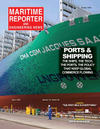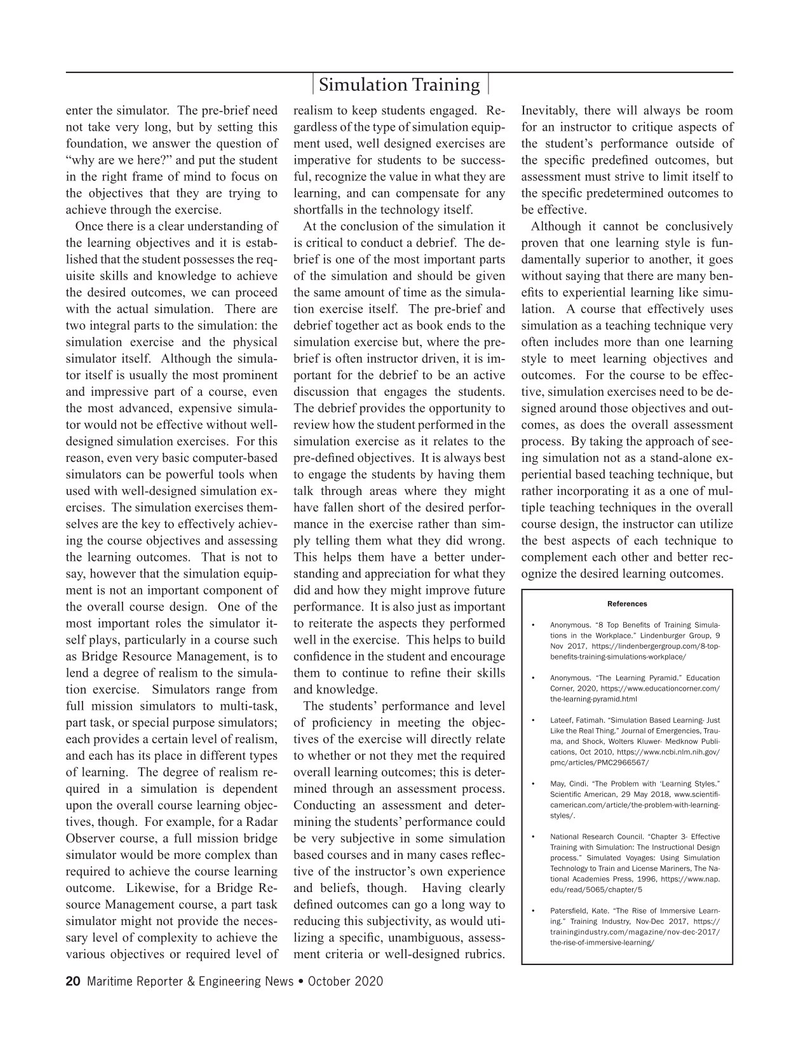
Page 20: of Maritime Reporter Magazine (October 2020)
Shipping & Port Annual
Read this page in Pdf, Flash or Html5 edition of October 2020 Maritime Reporter Magazine
Simulation Training enter the simulator. The pre-brief need realism to keep students engaged. Re- Inevitably, there will always be room not take very long, but by setting this gardless of the type of simulation equip- for an instructor to critique aspects of foundation, we answer the question of ment used, well designed exercises are the student’s performance outside of “why are we here?” and put the student imperative for students to be success- the speci? c prede? ned outcomes, but in the right frame of mind to focus on ful, recognize the value in what they are assessment must strive to limit itself to the objectives that they are trying to learning, and can compensate for any the speci? c predetermined outcomes to achieve through the exercise. shortfalls in the technology itself. be effective.
Once there is a clear understanding of At the conclusion of the simulation it Although it cannot be conclusively the learning objectives and it is estab- is critical to conduct a debrief. The de- proven that one learning style is fun- lished that the student possesses the req- brief is one of the most important parts damentally superior to another, it goes uisite skills and knowledge to achieve of the simulation and should be given without saying that there are many ben- the desired outcomes, we can proceed the same amount of time as the simula- e? ts to experiential learning like simu- with the actual simulation. There are tion exercise itself. The pre-brief and lation. A course that effectively uses two integral parts to the simulation: the debrief together act as book ends to the simulation as a teaching technique very simulation exercise and the physical simulation exercise but, where the pre- often includes more than one learning simulator itself. Although the simula- brief is often instructor driven, it is im- style to meet learning objectives and tor itself is usually the most prominent portant for the debrief to be an active outcomes. For the course to be effec- and impressive part of a course, even discussion that engages the students. tive, simulation exercises need to be de- the most advanced, expensive simula- The debrief provides the opportunity to signed around those objectives and out- tor would not be effective without well- review how the student performed in the comes, as does the overall assessment designed simulation exercises. For this simulation exercise as it relates to the process. By taking the approach of see- reason, even very basic computer-based pre-de? ned objectives. It is always best ing simulation not as a stand-alone ex- simulators can be powerful tools when to engage the students by having them periential based teaching technique, but used with well-designed simulation ex- talk through areas where they might rather incorporating it as a one of mul- ercises. The simulation exercises them- have fallen short of the desired perfor- tiple teaching techniques in the overall selves are the key to effectively achiev- mance in the exercise rather than sim- course design, the instructor can utilize ing the course objectives and assessing ply telling them what they did wrong. the best aspects of each technique to the learning outcomes. That is not to This helps them have a better under- complement each other and better rec- say, however that the simulation equip- standing and appreciation for what they ognize the desired learning outcomes.
ment is not an important component of did and how they might improve future
References the overall course design. One of the performance. It is also just as important most important roles the simulator it- to reiterate the aspects they performed • Anonymous. “8 Top Bene? ts of Training Simula- tions in the Workplace.” Lindenburger Group, 9 self plays, particularly in a course such well in the exercise. This helps to build
Nov 2017, https://lindenbergergroup.com/8-top- bene? ts-training-simulations-workplace/ as Bridge Resource Management, is to con? dence in the student and encourage lend a degree of realism to the simula- them to continue to re? ne their skills • Anonymous. “The Learning Pyramid.” Education
Corner, 2020, https://www.educationcorner.com/ tion exercise. Simulators range from and knowledge.
the-learning-pyramid.html full mission simulators to multi-task, The students’ performance and level • Lateef, Fatimah. “Simulation Based Learning- Just part task, or special purpose simulators; of pro? ciency in meeting the objec-
Like the Real Thing.” Journal of Emergencies, Trau- each provides a certain level of realism, tives of the exercise will directly relate ma, and Shock, Wolters Kluwer- Medknow Publi- cations, Oct 2010, https://www.ncbi.nlm.nih.gov/ and each has its place in different types to whether or not they met the required pmc/articles/PMC2966567/ of learning. The degree of realism re- overall learning outcomes; this is deter- • May, Cindi. “The Problem with ‘Learning Styles.” quired in a simulation is dependent mined through an assessment process.
Scienti? c American, 29 May 2018, www.scienti? - camerican.com/article/the-problem-with-learning- upon the overall course learning objec- Conducting an assessment and deter- styles/.
tives, though. For example, for a Radar mining the students’ performance could • National Research Council. “Chapter 3- Effective
Observer course, a full mission bridge be very subjective in some simulation
Training with Simulation: The Instructional Design simulator would be more complex than based courses and in many cases re? ec- process.” Simulated Voyages: Using Simulation
Technology to Train and License Mariners, The Na- required to achieve the course learning tive of the instructor’s own experience tional Academies Press, 1996, https://www.nap.
outcome. Likewise, for a Bridge Re- and beliefs, though. Having clearly edu/read/5065/chapter/5 source Management course, a part task de? ned outcomes can go a long way to • Paters? eld, Kate. “The Rise of Immersive Learn- ing.” Training Industry, Nov-Dec 2017, https:// simulator might not provide the neces- reducing this subjectivity, as would uti- trainingindustry.com/magazine/nov-dec-2017/ sary level of complexity to achieve the lizing a speci? c, unambiguous, assess- the-rise-of-immersive-learning/ various objectives or required level of ment criteria or well-designed rubrics. 20 Maritime Reporter & Engineering News • October 2020
MR #10 (18-33).indd 20 10/6/2020 8:43:59 AM

 19
19

 21
21
